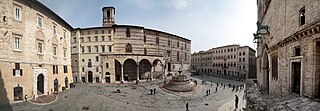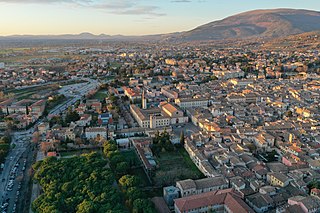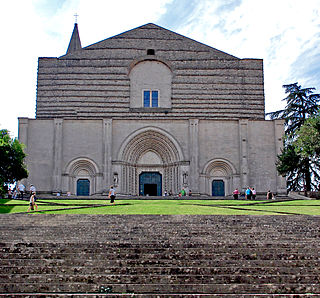Perugia is a city in central Italy, the capital of Umbria.
Contents
Perugia may also refer to:
Perugia is a city in central Italy, the capital of Umbria.
Perugia may also refer to:

Perugia is the capital city of Umbria in central Italy, crossed by the River Tiber, and of the province of Perugia. The city is located about 164 km (102 mi) north of Rome and 148 km (92 mi) southeast of Florence. It covers a high hilltop and part of the valleys around the area. The region of Umbria is bordered by Tuscany, Lazio, and Marche.

Terni is a city in the southern portion of the region of Umbria in central Italy. It is near the border with Lazio. The city is the capital of the province of Terni, located in the plain of the Nera river. It is 104 kilometres northeast of Rome and 81 km south of the regional capital, Perugia.
Assisi is a town and comune of Italy in the Province of Perugia in the Umbria region, on the western flank of Monte Subasio.

Todi is a town and comune (municipality) of the province of Perugia in central Italy. It is perched on a tall two-crested hill overlooking the east bank of the river Tiber, commanding distant views in every direction.

Gubbio is an Italian town and comune in the far northeastern part of the Italian province of Perugia (Umbria). It is located on the lowest slope of Mt. Ingino, a small mountain of the Apennines.

Foligno is an ancient town of Italy in the province of Perugia in east central Umbria, on the Topino river where it leaves the Apennines and enters the wide plain of the Clitunno river system. It is located 40 kilometres south-east of Perugia, 10 km (6 mi) north-north-west of Trevi and 6 km (4 mi) south of Spello.

Nocera Umbra is a town and comune in the province of Perugia, Italy, 15 kilometers north of Foligno, at an altitude of 520 m above sea-level. The comune, covering an area of 157.19 km², is one of the largest in Umbria.

Constantius of Perugia is one of the patron saints of Perugia, Italy.

Jacopone da Todi, O.F.M. was an Italian Franciscan friar from Umbria. He wrote several laude in the local vernacular. He was an early pioneer in Italian theatre, being one of the earliest scholars who dramatised Gospel subjects.

Assisi Cathedral, dedicated to San Rufino is a major church in Assisi, Italy. This stately church in Umbrian Romanesque style was the third church built on the same site to contain the remains of bishop Rufinus of Assisi, martyred in the 3rd century. The construction was started in 1140 to the designs by Giovanni da Gubbio, as attested by the wall inscription visible inside the apse. He may be the same Giovanni who designed the rose-window on the façade of Santa Maria Maggiore in 1163.

Perugia Cathedral is a Roman Catholic cathedral in Perugia, Umbria, central Italy, dedicated to Saint Lawrence. Formerly the seat of the bishops and archbishops of Perugia, it has been since 1986 the archiepiscopal seat of the Archdiocese of Perugia-Città della Pieve.

Andrew of Perugia was a Franciscan friar and Bishop born in Perugia, Italy, and active in China in the 14th century. He was Bishop of Quanzhou in Fujian from 1322.
Bartolomeo or Bartolommeo is a masculine Italian given name, the Italian equivalent of Bartholomew. Its diminutive form is Baccio. Notable people with the name include:
Saint John or St. John usually refers to John the Baptist, but also, sometimes, to John the Apostle.
Agostino is both a masculine Italian given name and an Italian surname. Notable people with the name include:

Banca dell'Umbria 1462 S.p.A. or previously known as Cassa di Risparmio di Perugia was an Italian savings bank. The bank became a subsidiary of UniCredit in 1999 and ceased to exist in 2005. However, its former owner Fondazione Cassa di Risparmio di Perugia, still operated as a charity organization. The foundation and the S.p.A. were split in 1992 from the original statutory corporation of the bank due to Legge Amato.

San Fortunato is a Gothic- and Renaissance-style, Roman Catholic church in the center of Todi, province of Perugia, region of Umbria, Italy.

The Enthroned Madonna and Child with Saints Paul and Francis is a painting by the Italian Renaissance painter Antoniazzo Romano. It was originally the main altarpiece of the church of San Paolo, part of a Franciscan monastery. In the 20th century, it was requisitioned and restored at the request of the art historian Adolfo Venturi, and now is housed in the Galleria Nazionale d'Arte Antica of Palazzo Barberini, Rome.
Verona is a feminine given name and a surname which may refer to:

The Temple of Jupiter Apenninus or Temple of Jupiter Poeninus was an Umbrian-Roman temple that lay at the foot of Monte Catria, near the modern village of Scheggia, between today's Umbria and Marche regions, in Italy. The temple stood near the ancient Via Flaminia, 200 km from Rome, where the road crossed the Apennines. The structure, once one of the most important Umbrian shrines, has now completely disappeared.